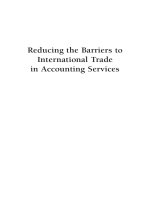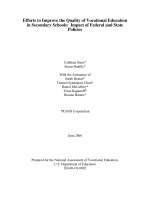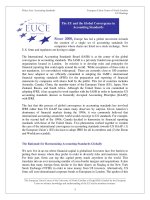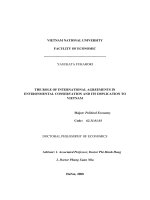Reducing the Barriers to International Trade in Accounting Services doc
Bạn đang xem bản rút gọn của tài liệu. Xem và tải ngay bản đầy đủ của tài liệu tại đây (296.1 KB, 72 trang )
Reducing the Barriers to
International Trade
in Accounting Services
AEI STUDIES ON SERVICES TRADE NEGOTIATIONS
Claude E. Barfield, series editor
REDUCING THE BARRIERS TO INTERNATIONAL
TRADE IN ACCOUNTING SERVICES
Lawrence J. White
INSURANCE IN THE GENERAL AGREEMENT ON TRADE IN SERVICES
Harold D. Skipper, Jr.
Reducing the Barriers to
International Trade
in Accounting Services
Lawrence J. White
The AEI Press
Publisher for the American Enterprise Institute
WASHINGTON, D.C.
2001
Available in the United States from the AEI Press, c/o Publisher
Resources Inc., 1224 Heil Quaker Blvd., P.O. Box 7001, La Vergne, TN
37086-7001. To order, call 1-800-937-5557. Distributed outside the
United States by arrangement with Eurospan, 3 Henrietta Street,
London WC2E 8LU, England.
ISBN 8447-7157-0
1 3 5 7 9 10 8 6 4 2
© 2001 by the American Enterprise Institute for Public Policy Research,
Washington, D.C. All rights reserved. No part of this publication may be
used or reproduced in any manner whatsoever without permission in
writing from AEI except in the case of brief quotations embodied in
news articles, critical articles, or reviews.
The AEI Press
Publisher for the American Enterprise Institute
1150 17th Street, N.W.
Washington, D.C. 20036
Printed in the United States of America
v
Contents
FOREWORD, Claude E. Barfield v
ACKNOWLEDGMENTS xi
1INTRODUCTION 1
2B
ACKGROUND 3
3WHY INTERNATIONAL TRADE IN SERVICES IS
(AND IS NOT) DIFFERENT FROM TRADE IN GOODS 5
4ACCOUNTING SERVICES IN INTERNATIONAL TRADE 11
5THE IMPEDIMENTS TO TRADE IN ACCOUNTING SERVICES 18
6D
IFFERING ACCOUNTING STANDARDS: HOW
IMPORTANT IS HARMONIZATION?22
7THE CURRENT FRAMEWORK FOR NEGOTIATIONS 28
8T
HE ROAD AHEAD 34
9CONCLUSION 37
NOTES 39
R
EFERENCES 43
G
LOSSARY OF TRADE TERMS 47
A
BOUT THE AUTHOR 55
vii
Foreword
T
he service sector accounts for more than 70 percent
of the gross domestic product (GDP) of advanced
industrial economies. Though trade in services is dif-
ficult to calculate and many transactions still go uncounted,
current estimates place the worth of such trade as at least
$2.5 trillion, or about a third of total world trade.
For the United States, the world’s most advanced indus-
trial economy, the service sector looms even larger. Services
account for almost 80 percent of U.S. production and U.S.
employment (while manufacturing accounts for 19 percent
of U.S. GDP and 18 percent of U.S. employment). The sur-
plus in U.S. services trade also partially offsets persistent
U.S. merchandise trade deficits. In 1999, the services trade
surplus was $76 billion; the merchandise deficit, $347 bil-
lion.
Despite the increasing importance of services trade and
investment, only in 1995 did the multilateral trading system
establish rules for opening markets in these economic sec-
tors by negotiating the General Agreement on Trade in
Services (GATS). This first effort at a discipline for services
trade and investment created a framework of general princi-
ples and rules but left the large-scale liberalization of indi-
vidual sectors to later negotiations.
Subsequently, under a mandate established as a part of
the Uruguay Round negotiations, important advances
toward real liberalization were achieved in two key sectors,
telecommunications (1998) and financial services (1999),
and services negotiations continued after the Round. In
addition, members of the new World Trade Organization
also committed themselves during the Uruguay Round to
begin a new round of services trade negotiations in the year
2000.
Against this backdrop the American Enterprise Institute
launched a new research project focusing on this next round
of negotiations. Services 2000, as the new negotiations are
called, are building on the unfinished agenda of the
Uruguay Round and will, it is hoped, break new ground in
areas such as market access liberalization, additional archi-
tectural reforms in the GATS structure, and horizontal
(cross-sectoral) rulemaking regarding safeguards, govern-
ment procurement, and subsidies.
The American Enterprise Institute project was mounted
in conjunction with a group of other research institutions—
the Kennedy School of Government at Harvard University
and the Brookings Institution—and with the U.S. Coalition
of Services Industries. AEI undertook a series of individual
sectoral analyses. We commissioned papers on eight sectors:
financial services (banks and securities), accounting, insur-
ance, entertainment and culture, air freight and air cargo,
airline passenger service, electronic commerce, and energy.
Each study aimed to identify major barriers to trade liberal-
ization in the sector under scrutiny and to present and
assess liberalization policy options for trade negotiators and
interested private-sector participants.
AEI would like to acknowledge the following donors for
their generous support of the trade in services project,
which provided some of the funding that allowed these
studies to go forward: American Express Company,
American International Group Inc., Enron Corporation,
FedEx Corporation, Mastercard International Inc., the
viii FOREWORD
Motion Picture Association of America, and the Mark Twain
Institute. I emphasize, however, that the conclusions and
recommendations of the individual studies are solely those
of the authors.
Dissemination of the preliminary results of the research
began even before the final drafts were finished. During
1999 and 2000, individual scholars made contributions to a
series of meetings and conferences, including: the first
World Services Congress in Atlanta and a preliminary
agenda-setting seminar in Washington; and three interna-
tional conferences in Chile, Costa Rica, and Hong Kong. In
addition, AEI hosted conferences on financial services and
transportation in Washington, and co-sponsored a confer-
ence on electronic commerce in Seattle. Further conferences
are planned as the individual studies are published over the
next year.
In this monograph, Lawrence J. White of the Stern School
of Business at New York University analyzes the challenges
facing GATS negotiators in the field of accounting and pro-
vides recommendations for meeting those challenges.
Accounting services are part of a larger group of professional
services that are of major importance for the United States,
and a group of sectors in which America generally holds a
strong comparative advantage. Analysts estimate that about
30 million Americans are employed in professional services
such as accounting, law, architecture, and engineering. The
combined sectors contribute about $10 billion to U.S. bal-
ance of payments receipts, according to figures compiled by
the U.S. Department of Commerce.
Accounting is the most global of the professional services,
and for that reason the World Trade Organization Working
Party on Professional Services chose this sector as the first
priority for achieving a detailed sectoral agreement under
the new GATS. In addition, the Asian crisis in the late 1990s
brought heightened urgency to the need for more sophisti-
CLAUDE E. BARFIELD ix
cated and analytically rigorous accounting rules.
Policymakers and financial leaders widely agreed that poor
accounting practices contributed to a lack of transparency
regarding the true financial conditions of many manufactur-
ing and financial institutions. In turn, inadequate investor
information and a distrust of the integrity of available infor-
mation impeded economic recovery in a number of Asian
countries.
In this study White describes the “public good” aspect of
the liberalization of accounting services by demonstrating
that increased competition through market access leads to
improved professional standards and ultimately to more effi-
cient capital markets.
On the agenda of GATS 2000, two distinct sets of issues
are the focus of negotiations: Market access and national
treatment issues that fall under GATS Articles XVI and XVII,
and domestic regulatory practices that fall under GATS
Article VI.
Regarding market access issues, White lays out and rebuts
much of the traditional rationale for excluding foreign com-
petitors on the basis of consumer protection. He argues that
the widespread market access “regulatory restrictions that
[accounting] firms face force them into inefficient compro-
mises that impede the flow of personnel and information
and restrict organization forms and structures that would
allow greater efficiency.” And he identifies the major imped-
iments that will form the basis for negotiations in the future
and that will be overcome only by more liberal accounting
sectoral commitments by individual WTO members.
Regarding differing domestic regulatory accounting
frameworks, White analyzes the pros and cons of harmo-
nization and mutual recognition. And he provides a list of
pro-competitive regulatory principles that could accomplish
the goal of establishing “best practices” that would serve as
a model for gradual harmonization—and possibly the basis
x FOREWORD
for an annex to the GATS accounting agreement (similar to
the regulatory annex in the GATS telecommunications
agreement).
Finally, this monograph and the accounting sector itself
point up a continuing tension in service sector negotiations:
domestic regulators can themselves become impediments to
trade liberalization unless they are convinced that such lib-
eralization serves the national interest. In the case of
accounting services, the U.S. Securities and Exchange
Commission has thus far opposed new international rules
because of its belief that new World Trade Organization
rules would dilute and weaken regulatory safeguards in this
country. Thus, overcoming U.S. regulators’ apprehensions
presents as large a challenge for U.S. trade negotiators as
overcoming opposition to accounting liberalization among
other WTO member states.
C
LAUDE E. BARFIELD
American Enterprise Institute
CLAUDE E. BARFIELD xi
Acknowledgments
T
hanks are due to Claude Barfield, Charles Heeter,
John Hegarty, Harry Freeman, and Vincent Sacchetti
for valuable comments on earlier drafts.
1
Introduction
A
ccountants and accounting are essential—though
often undervalued—elements of the infrastructure of
any enterprise. Information about a firm’s financial
accounts is vital for managers, owners, and creditors; it is a
key input for lenders’ and investors’ decisions as to whether,
when, and how to provide finance to enterprises.
1
Accounting is thus an important part of the business sector
of any modern economy.
The growth of multinational enterprises generally, and of
multinational accounting firms in particular, has focused
attention on issues related to international trade in account-
ing services. This attention, in turn, is part of a rising tide of
interest in trade in a wide range of services.
The street-level disruptions at the Seattle Ministerial
Conference of the World Trade Organization in November
and December 1999 were an unfortunate slowing of the
general process of liberalizing international trade in goods
and services. Given the momentum of more than five
decades of international progress in reducing the barriers to
trade in goods and the recent substantial interest in liberal-
izing trade in services, however, it seems likely that the
Seattle events will represent only a brief stumble on the path
to freer international trade.
2 REDUCING THE BARRIERS TO INTERNATIONAL TRADE
Prior to the Ministerial Conference, substantial progress
had been made with respect to establishing international
commitments for freer trade in accounting services, and it
seems likely that this progress will continue. The reasons for
this progress, and why it matters, will be the major focus of
this study.
3
2
Background
B
eginning in the late 1970s, there was a growing real-
ization that trade in services should be the next area
to be targeted for reductions in trade barriers.
Substantial progress had been made since the end of the
Second World War in reducing barriers to trade in goods
through a succession of multilateral negotiating “rounds”
under the auspices of the General Agreement on Tariffs and
Trade (GATT). Though international trade in goods was
hardly free of all protectionist restraints, and considerably
more progress could (and would) be made, trade in services
had been largely untouched.
Trade in services became a major topic of discussion dur-
ing the so-called Uruguay Round of GATT negotiations in
the late 1980s. Those negotiations ultimately led to the cre-
ation of the World Trade Organization (WTO) as the suc-
cessor to the GATT, and to a General Agreement on Trade in
Services (GATS), which has served as the vehicle for the spe-
cific negotiations concerning reductions in the barriers to
international trade in services.
A major initiative focusing on professional services has
been included in these negotiations. The WTO Working
Party on Professional Services (WPPS),
2
which came into
existence in 1995, selected accounting as the first of the pro-
fessional services areas for which a set of multilateral “disci-
plines” (rules that limit the protectionist nature of the
4 REDUCING THE BARRIERS TO INTERNATIONAL TRADE
domestic regulatory requirements that typically apply to
accountants and accounting) would be developed. These
multilateral disciplines were adopted by the WTO’s Council
on Trade in Services in December 1998 and will serve as the
bases for reductions in international restrictions at the con-
clusion of future negotiations.
3
Prior to the adoption of the
multilateral disciplines, the WPPS completed the develop-
ment of guidelines for the negotiation of mutual recognition
agreements (MRAs) that would apply to professional quali-
fications of accountants in various countries. These guide-
lines were adopted by the council in May 1997.
The choice of accounting as a lead sector for reducing
barriers was not accidental. Accounting already has a sub-
stantial international component; the largest accounting
firms have major international presences and have been
eager to operate in less restrictive environments. Accounting
is coming to be understood as a vital infrastructural element
of financial services, and as finance becomes more global,
accounting too should become more global. Similarly, as
large business enterprises generally have increased their
international operations, their need for international
accounting services has grown.
Despite the considerable international presences of the
major accounting firms, however, virtually all countries main-
tain various types of restrictions that impede the flow of
accounting services across borders. The broad provisions of
the GATS and the multilateral accounting disciplines that were
adopted by the WTO in 1998 will apply only after further
negotiations are completed. In the interim, WTO members are
committed to a “standstill” arrangement: they will refrain from
imposing heightened barriers to trade in accounting services.
4
The substantial barriers that are currently in place provide
prime targets for efforts to reduce and remove restrictions.
Even in the wake of the Seattle experience, substantial
progress can and should be made.
5
3
Why International Trade in
Services Is (and Is Not)
Different from
Trade in Goods
I
n many respects international trade in services is impor-
tantly different from trade in goods. Indeed, the fact that
multilateral negotiations on trade in services began in
earnest
four decades after the beginning of multilateral nego-
tiations on trade in goods is a testament to this difference.
Nonetheless, there is at least one important way in which
trade in services is not different: it provides the potential for
improving a country’s allocation of resources and thus raising
its overall standard of living. This chapter will first explore
the latter notion, in order to motivate the general discussion
in this study of the importance of reducing the barriers to
international trade in accounting services. We will then turn
to the important ways that services are different.
Trade in Services Is Not Different: Improving Efficiency
The basic economics argument for reducing or eliminating
impediments to trade rests on the improvements in effi-
ciency in the allocation of a country’s resources that result
from such actions.
5
In essence, trade allows a country to
focus its resources and energies on what it does relatively
better than the rest of the world, importing those things that
it does less well and paying for its imports by exporting the
things that it does especially well. Though there are legiti-
mate theoretical exceptions that can be offered to the free-
trade argument, the fundamental case for free trade is a
powerful one, and it has now been buttressed by decades of
empirical evidence indicating that reduced barriers to trade
generally have had the beneficial effects that have been
promised.
Though the case for free trade is almost always couched
in terms of flows of goods, the same principles are equally
valid when applied to trade in services. If a country is rela-
tively less efficient at producing a set of services than are
some other countries, then the first country will generally be
better off by allowing the others to supply those services and
instead focusing its resources on the goods and services in
which it is relatively more efficient.
At its heart, the case for the beneficial consequences of
free (or freer) trade is just the case for competitive markets,
expanded to an international context. The case for compet-
itive markets is as applicable to services as it is to goods; so
is the case for free trade.
The Ways in Which Trade in Services Is Different
Understanding international trade in goods is relatively
straightforward: goods can be seen. They move physically
across borders. Their movement is easy to visualize, as are
many of the impediments to their movement: tariffs, quotas,
and even more subtle impediments, such as customs delays
at borders and regulatory procedures that favor national
producers over foreign producers.
Trade in services is different, in at least two important
ways. First, services are usually intangible. They cannot be
seen, held, touched, or smelled. They usually do not physi-
6 REDUCING THE BARRIERS TO INTERNATIONAL TRADE
cally cross borders the way that goods do. Second, services
are often extensively regulated by governments—more often
than is true for goods. Appreciating both differences is use-
ful for understanding why liberalization negotiations have
been slower for services than for goods.
Intangibility. Because services are invisible (indeed, inter-
national services remittances are sometimes described as
part of “invisibles” in discussions of a country’s balance of
payments), they are not delivered in the same way as is true
for goods. The following four methods of delivery are listed
in Article I of the GATS and are frequently described as the
four modes of supply under the GATS.
Cross-border. Some services do actually cross borders. This
is true for electricity and electronic information and also for
some financial services (for example, a bank that has its
offices in country A may grant a loan to or accept a deposit
from a customer that is located in country B). But these serv-
ices do not stop and wait at a port of entry while a customs
official inspects and categorizes them and levies a duty.
Instead, they move instantaneously and invisibly.
Consumption abroad. Some services involve the travel of
the customer from country B to the location of the enterprise
that offers the services in country A. Tourism is a common
example.
Commercial presence. Some services may best be delivered
through the establishment of a physical presence at one or
more specific locations. For example, a bank that is head-
quartered in country A may prefer to establish a branch
location in country B in order to do business with customers
in the latter country. Many long-term service relationships
are best developed and enhanced through the local presence
of physical establishments.
Temporary presence (presence of natural persons). Some
services may be provided on a temporary basis, through the
LAWRENCE J. WHITE 7
nationals of country A visiting country B to deliver the serv-
ices. Entertainment services (such as concerts by visiting
orchestras or rock stars), short-term consultancies, or con-
struction services can be delivered in this fashion.
Some services can be delivered through a combination of
two or more of these methods.
The commercial presence method is common in services,
but this commercial presence means that the delivery of the
service in country B will require a services firm that is head-
quartered in country A to make investments in country B in
order to establish that location. In addition, personnel from
the service deliverer’s headquarters will have to visit the
branch location in country B to deliver services, to hire local
personnel, and to supervise those personnel. This need for
investment and staffing that must originate from country A
in order to deliver services in country B clearly makes the
process of delivering services across borders more compli-
cated than is true for the simple shipment of goods, and it
provides greater and more subtle opportunities for govern-
ments to impede the flow of services. Restrictions on
inbound foreign investment (including ownership struc-
tures and arrangements), on immigration, and on commer-
cial location and establishment will all restrict the inflow of
services.
The delivery of accounting services is highly dependent
on the physical presence of local establishments (the com-
mercial presence method). In addition, the larger account-
ancy firms (see chapter 4) make liberal use of short-term
consultancies (the temporary presence method) in their
efforts to mobilize specific sources of expertise within their
firms. Whether the continuing technological revolution in
telecommunications and data processing will allow account-
ing firms to be less dependent on these methods and instead
to provide more of their services from afar—the cross-
border method—remains an open question.
8 REDUCING THE BARRIERS TO INTERNATIONAL TRADE
As will be discussed in chapter 5, given the current meth-
ods of delivering accounting services, the types of restric-
tions discussed above are indeed important impediments to
the flow of accounting services.
Regulation. Services are more susceptible to various forms
of governmental regulation or outright government owner-
ship. As of the 1970s, the typical list of industries in the
United States that were described as “heavily regulated” (or,
outside of the United States, were either regulated or in the
hands of governments) included transportation services (air,
rail, road, water), telecommunications services (broadcast-
ing, telephony), financial services (banking, insurance, secu-
rities), and electricity.
6
These industries became the prime
targets for the deregulation efforts of the late 1970s and the
1980s in the United States (and for deregulation and priva-
tization efforts in other countries). Despite the substantial
deregulation that has occurred, however, these sectors con-
tinue to be more regulated than most other areas of the U.S.
economy.
7
In addition, professional services (for example, medicine,
law, accounting, architecture, and engineering) have been
subject to extensive direct and indirect governmental regu-
lation. The direct form of regulation occurs through the
actions of formal government agencies. The indirect form
occurs when governments delegate to professional organiza-
tions many of the regulatory roles that would otherwise be
exercised by government; even when such roles are dele-
gated, the ultimate regulatory powers are still held by gov-
ernments.
The reasons for the extensive government involvement in
the delivery of these services vary, but consumer protection
is a common theme.
8
In turn, consumer protection may be
couched either in terms of protection against the exercise of
monopoly power or in terms of protection against the
LAWRENCE J. WHITE 9
abuses that could arise from the complicated nature of the
services and the superior knowledge of the services provider
vis-à-vis the customer.
9
But it is an easy jump from regula-
tion that is supposed to protect consumers to regulation that
is “captured” by the regulated entities; in the latter case, reg-
ulation may well harm consumers by protecting the incum-
bent services providers from the rigors of competition.
10
The extensive overlay of regulation of many services thus
adds important elements to any efforts to liberalize interna-
tional trade in these services. First, the regulation is present,
and arguably it is there for a reason. Efforts to liberalize
trade have to confront the question of whether trade in serv-
ices is compatible with the protections that the regulation is
supposed to provide. Next, extra procedures, extra laws,
and extra agencies must be dealt with. Finally, the incum-
bent firms can wrap themselves in the mantle of consumer
protection and argue to home-country government officials
that this protection will be weakened if providers from
abroad are allowed under the tent. As will be discussed in
chapter 5, these patterns of professional-services regulation
apply squarely to accounting.
In sum, services are different from goods. Their mode of
delivery and their tendency to be regulated have created
delays and extra barriers to the opening of trade in services.
Indeed, the structure of the GATS recognizes these differ-
ences and sets less ambitious goals for the dismantling of
barriers in the services areas than is true for goods.
Nevertheless, the GATS represents a substantial effort
toward freer trade in services, and accounting services are an
important part of that effort. We now turn to a deeper explo-
ration of accounting services.
10 REDUCING THE BARRIERS TO INTERNATIONAL TRADE
11
4
Accounting Services in
International Trade
T
he scope of “accounting services”
11
is usually under-
stood to include accounting and bookkeeping (meas-
uring and recording the financial flows and positions
of an enterprise), auditing (verifying and attesting/certifying
the accuracy of the financial position and results of the
enterprise, for internal or external purposes), and tax prepa-
ration. Clearly, the three activities are closely related.
In addition, over the past few decades the largest account-
ing firms—especially in the United States—have become
actively involved in management consulting, and growth in
this area has been considerably more rapid than for the
firms’ more traditional services. As can be seen in table 1, as
of 1998 management consulting contributed almost half (47
percent) of the domestic revenues of the hundred largest
U.S. accounting firms, with accounting, auditing, and tax
services contributing the remainder (53 percent). For the
largest of the large—the “Big Five”
12
firms—the correspond-
ing percentages were 51 percent and 49 percent, respec-
tively. For the Big Five, their defining services are no longer
their dominant sources of revenues!
13
Between 1997 and
1998 management consulting revenues grew by 38 percent
for both the largest hundred and the Big Five.









